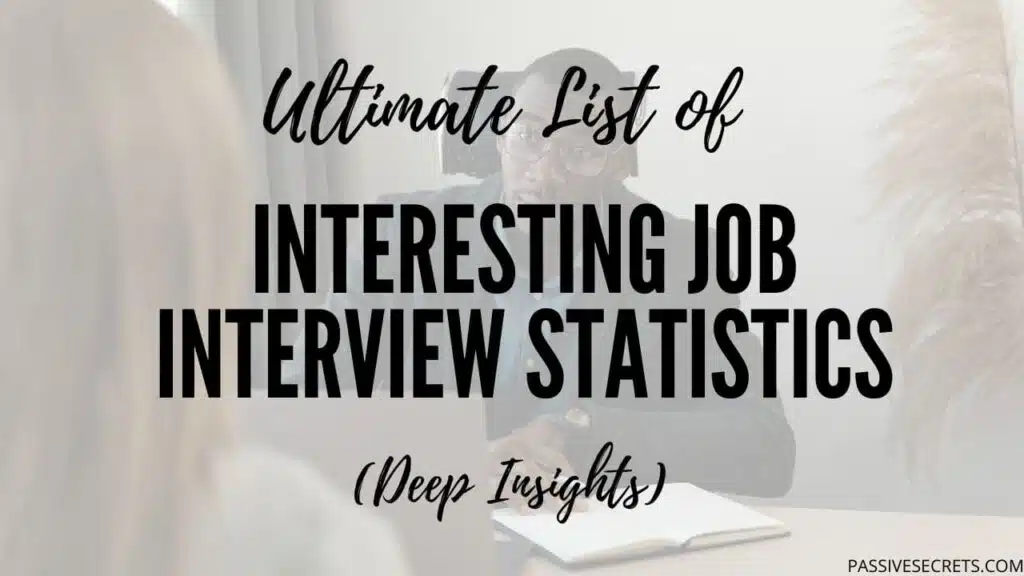
Have you ever thought about what goes on behind the scenes of a job interview? You know, those nerve-wracking moments when trying to impress a potential employer?
Well, job interview statistics give us a peek into this world.
These interesting statistics are like a backstage pass to the hiring process, showing us exciting trends like common interview questions and the chances of getting that callback.
Knowing these numbers can give you a leg up in your job search, whether you’re just starting your career or looking to switch things up.
So, let’s take a closer look at the fascinating world of job interview statistics and see what they can teach us about acing that next interview!
Key Job Interview Statistics
- The average time spent looking at a resume is 5-7 seconds.
- On average, 118 people apply for each job, with only 20% receiving interview invitations.
- Only 2% of applicants for job openings are usually chosen for an interview.
- The average time to respond after an interview is 24 business days.
- Typos or lousy grammar are immediate deal breakers for 77% of recruiters, and 35% reject candidates with unprofessional email addresses.
- A substantial 90.6% of employers prefer candidates with work experience.
- 76% of CVs are rejected if the email address is unprofessional.
- Nearly half (47%) of interviewers would not hire a candidate lacking knowledge about the company.
- 67% of recruiters believe eye contact is essential for establishing a good impression.
- In-person interviews usually last between 45 and 90 minutes, depending on the tasks or presentations required.
- Only 41% of candidates receive feedback after an interview, though 94% expect it.
- 95% of people try to appear younger during job interviews to improve their chances.
- Candidates typically receive one interview offer for every six applications submitted.
- Submitting five to ten applications per week increases the likelihood of landing an interview.
- Applicants submitting 21-80 applications have a 30% chance of getting an offer.
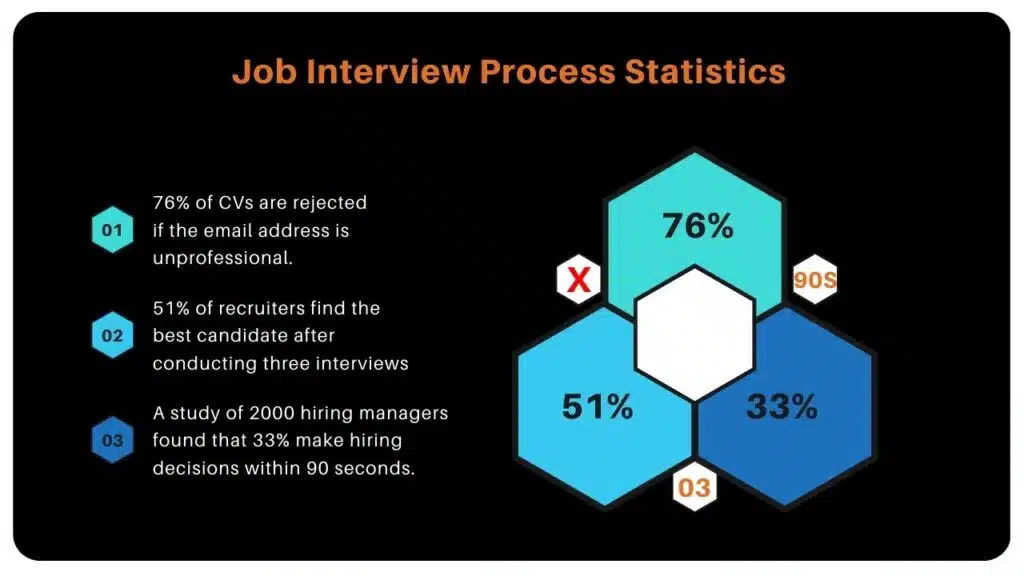
General Job Interview Statistics
1. Employers look for several vital qualities before making an offer. 36% value multitasking skills, 31% prioritize initiative, 21% seek creative thinking, and 12% look for other attributes in candidates. (source)
2. The average time spent looking at a resume is 5-7 seconds. (source)
3. On average, 118 people apply for each job, with only 20% receiving interview invitations. (source)
4. Just 38.2% of candidates receive information beyond the interview date and location before the actual interview. (source)
5. Interviews typically last 40 minutes, with phone interviews averaging 30 minutes. (source)
6. Feedback timing varies, with 44% of candidates hearing back within a few weeks, 37% within a week, and less than 4% within a day. (source)
7. Most of the time, only 2% of those who apply for a job opening are chosen for an interview. (source)
8. The average response time after an interview is 24 business days. (source)
9. Nearly half (47%) of interviewers would not hire a candidate who lacks knowledge about what the company does. (source)
10. 81% of candidates admit lying during job interviews. (source)
11. A substantial 90.6% of employers prefer candidates with work experience. (source)
12. Typos or lousy grammar are immediate deal breakers for 77% of recruiters, and 35% reject candidates with unprofessional email addresses. (source)
13. In-person interviews usually last between 45 and 90 minutes, depending on the tasks or presentations required. (source)
14. Some employers hire candidates within 24-48 hours if they are impressed by their interview performance. (source)
15. 60% of recruiters utilize video interviews in their hiring process. (source)
16. The average hiring process in the U.S. takes about 23.8 days, slightly longer than the 2014 average of 22.9 days. (source)
17. A positive interview experience influences 76% of candidates to accept a job offer. (source)
18. 45% of candidates who ghost employers do so after an interview. (source)
19. In the UK, candidates spend an average of £52 on travel and accommodation for face-to-face interviews. They also spend about £58 on purchasing new and appropriate clothes for the interview. (source)
20. Only 41% of candidates receive feedback after an interview, though 94% expect it. (source)
21. A striking 93% of people experience anxiety over job interviews. (source)
22. 38.3% of applicants don’t receive an interview invite even after ten applications. (source)
23. Most candidates, 92%, believe a mock interview is an essential preparation. (source)
24. A majority, 52%, of candidates view the interview process positively if informed about the next steps. (source)
25. Only 1 in 4 candidates report having an excellent interview experience. (source)
26. Employers have ghosted 53% of candidates. 31% being ghosted after a response before scheduling an interview. (source)
27. 95% of people try to appear younger during job interviews to improve their chances. (source)
28. Age discrimination is reported in 85% of finance, 84% of advertising, and 81% of digital marketing positions. (source)
29. 75% of U.S. employees confirmed they had experienced ageism at some point during job hunting. 53% also say they currently experience it at work. (source)
30. Organizations often use competency-based questions to evaluate candidates’ skills. (source)
31. Nearly 80% of job candidates find video interviews difficult or more stressful than in-person ones. (source)
32. About 25% of job seekers prefer live video interviews over in-person ones. (source)
33. Applicants with white-sounding names were 50% more likely to be contacted for job interviews than those with typical black names. (source)
34. On average, assuming white job applicants get 9.5% more interview offers than assumed black ones. Also, the worst-performing companies, many of which are in the car industry, interviewed 23% more assumed white applicants than assumed black applicants. (source)
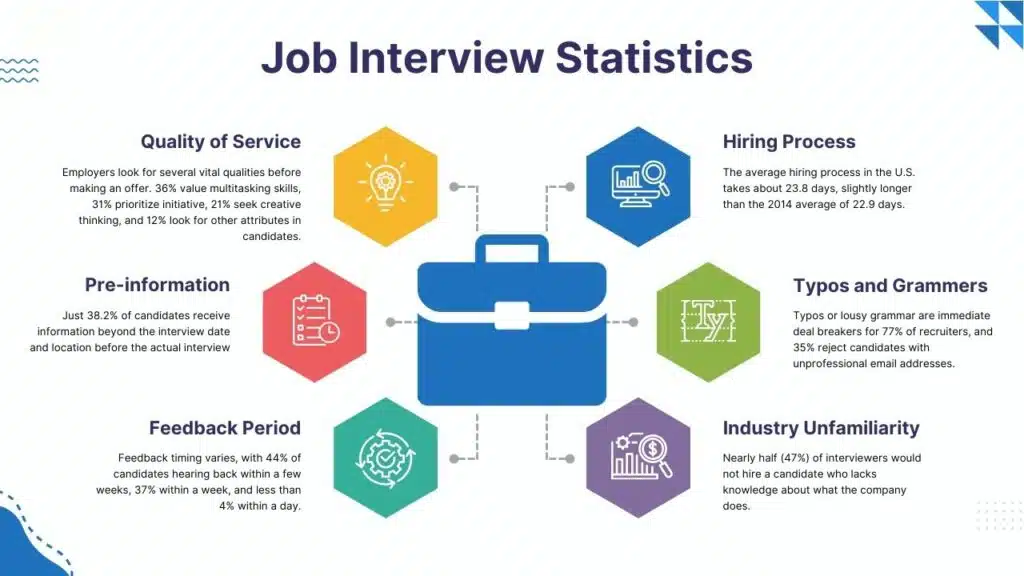
Job Interview Process Statistics
35. Candidates typically receive one interview offer for every six applications submitted. (source)
36. 76% of CVs are rejected if the email address is unprofessional. (source)
37. 51% of recruiters find the best candidate after conducting three interviews. (source)
38. A study of 2000 hiring managers found that 33% make hiring decisions within 90 seconds. (source)
39. A 50-year-old worker is up to three times less likely to get an interview than a 28-year-old. (source)
40. Applicants submitting 21-80 applications have a 30% chance of getting an offer. (source)
41. 60% of applications are abandoned due to lengthy processes. (source)
42. Using specialized recruiting platforms can reduce cost-per-applicant by 250%. (source)
43. Companies with over 5,000 employees take an average of 58 days to make an offer, even for non-technical roles. (source)
44. The typical interview process involves five stages, a standard practice for most companies. (source)
45. Responsiveness during the hiring process is most important for the UK (52%) and US (56%), up from the UK (43%) and US (47%) in 2021 and the UK (40%) and US (55%) in 2022. (source)
First Impression In Job Interview Statistics
46. 60% of interviewers decide on a candidate within the first 5-15 minutes. (source)
47. When it was time for the in-person interview, 65% of managers said they wouldn’t select a candidate who avoids eye contact. And 40% consider a candidate’s voice as a potential dealbreaker. (source)
48. 55% of recruiters base their decision on a candidate’s handshake, and a candidate’s smile influences 40%. (source)
49. Half of all managers judge candidates based on their clothing and behaviour before the interview. (source)
50. Candidates have just 7 seconds to make a positive first impression during a job interview. (source)
51. 55% of employers require smart-casual clothing, 19% have no dress code, and 26% require formal interview attire. (source)
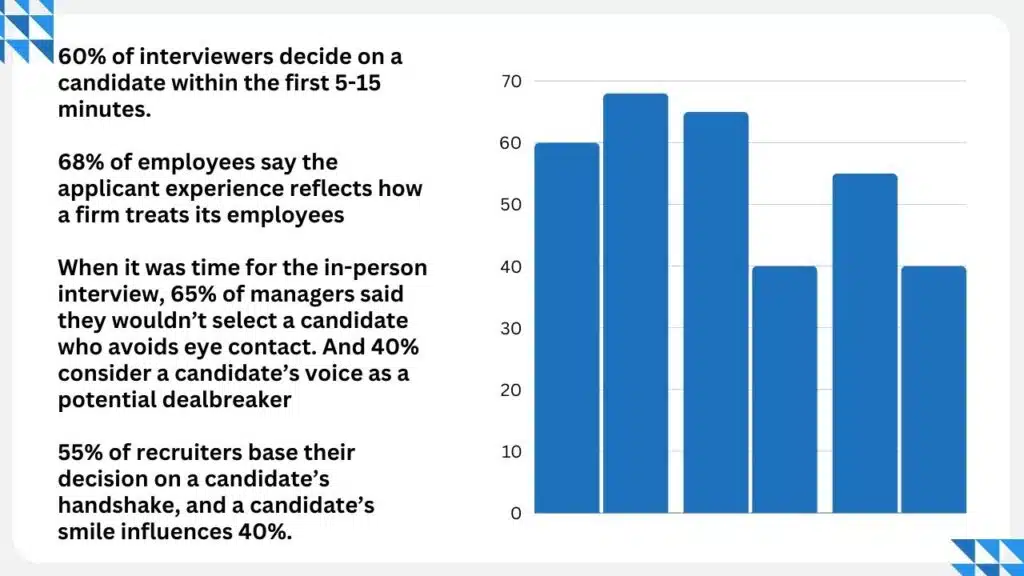
52. 59% of recruiters reject arrogant candidates, highlighting the importance of humility and a team-oriented attitude. (source)
53. 39% of job seekers leave a bad impression due to confidence issues, voice quality, or lack of a smile, emphasizing the importance of non-verbal cues. (source)
54. 68% of employees say the applicant experience reflects how a firm treats its employees. (source)
55. 69% of job interviewers made a first impression of someone before they could talk. Also, 83% were more positive about someone who appeared self-confident. (source)
56. 67% of recruiters believe eye contact is essential for establishing a good impression. (source)
Job Interview Statistics By Gender
57. Men are 33% more confident in their interview performance than women. (source)
58. Women are 30% less likely than men to be called for an interview with identical qualifications. (source)
59. A study reveals that women without children are 23.5% less likely to receive an interview call than men in the same circumstances. (source)
60. Women with children are 35.9% less likely to be called for an interview than fathers. (source)
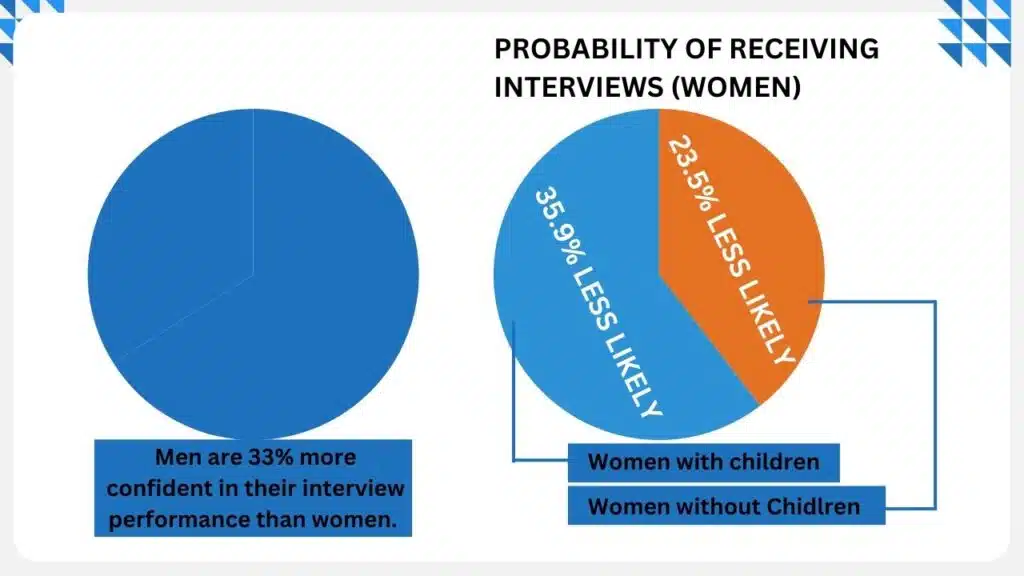
Job Hiring Statistics
Job interviews determine whether a candidate will be hired. That’s why you and your organization need to take note of the statistics to re-strategize and hire the right talent.
61. About 90% of employers review potential employees’ social media profiles, and 79% have rejected a candidate based on their findings. (source)
62. 98% of businesses conduct background research on applicants, with 43% using Google. Also, 80% of businesses consider a personal website important when evaluating candidates. (source)
63. Nearly 90% of candidates exit the hiring process due to mismatches in employee value propositions. (source)
64. The average cost per hire is $4,700, up from $4,129 in 2019, representing a 14% rise. (source and source)
65. 54% of French candidates view personal contact as crucial in the hiring process, compared to 53% in Germany, 29% in the UK, and only 18% in the US. (source)
66. 52% of job seekers declined a job offer due to poor experience. (source)
67. The average time-to-hire across industries is three to four weeks, with only 25% of respondents filling roles in under two weeks. (source)
68. 48% of businesses find their top-quality hires through employee referrals. (source)
69. 63% of recruiters say their biggest problem is finding enough suitable candidates to fill open positions. (source)
70. Millennials and Gen Z will comprise 75% of the global workforce by 2025. (source)
71. Corporate-level roles attract an average of 250 applications, with top candidates often interviewing with multiple companies simultaneously. (source)
72. 61% of interviewers and employers believe that 9:00 a.m. and 11:00 a.m. is the best time to interview for optimal alertness and responsiveness. (source)
73. Employers who emphasize diversity in their job postings receive 26% more applications from women. (source)
74. Companies with ethnically diverse boards are 13% more likely to outperform those with less diversity. (source)
Practices Of Recruiters During A Job Interview
75. Structured interview techniques are used by human resources 74% of the time to assess candidates systematically. (source)
76. Behavioral interviews, focusing on past behaviours to predict future performance, are used in 73% of cases. (source)
77. Phone screening, often employed as an initial step in candidate assessment and screening, is utilized by recruiters 57% of the time. (source)
78. Panel interviews, involving multiple interviewers assessing a candidate simultaneously, are utilized by 48% of HR professionals. (source)
79. A survey by Yello found that hiring managers (67%) spend between 30 minutes to 2 hours scheduling a single interview. (source)
80. According to the CareerBuilder survey, 25% of recruiters consider long paragraphs of text instant dealbreakers, while 17% say the same about resumes exceeding two pages. (source)
Statistics On The Use Of Technology In Job Interview
81. 79% of hiring managers use video technology to interview and evaluate candidates, a significant increase from previous years. (source)
82. 51% of recruiters use automated interview scheduling tools to streamline the process and improve efficiency. (source)
83. About 97.4% of Fortune 500 companies use application tracking software. (source)
84. 94% of recruiters and hiring professionals report that using recruitment software has positively impacted their hiring process. (source)
Virtual Interview Statistics
85. According to a LinkedIn survey, 81% of talent professionals and recruiters agree that virtual recruiting will continue post-Covid. (source)
86. A recent Indeed survey found that 82% of employers surveyed use virtual interviews, and 93% plan to continue using them. (source)
87. Only 46% of HR professionals in the U.S. feel prepared to adapt to virtual recruiting. (source)
88. According to SBAM, there has been a 49% increase in the popularity of online job interviews since 2011. (source)
89. In 2024, 69% of employers plan to use video interviews in their hiring process. (source)
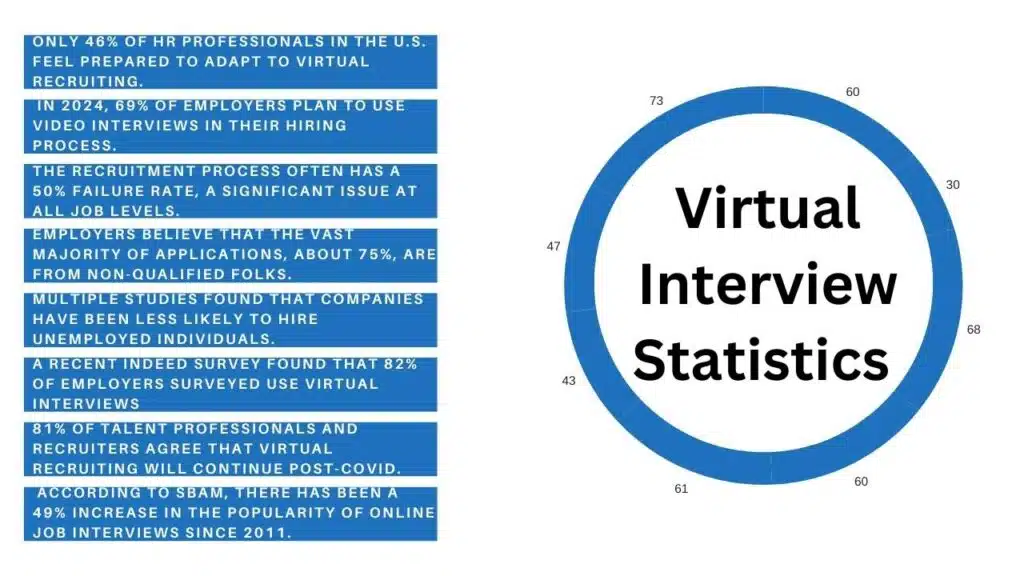
Success And Failure Rates Of Job Interview
90. Multiple studies found that companies have been less likely to hire unemployed individuals. (source)
91. Among job seekers with bachelor’s degrees, 51% went through the interview process without a job offer, compared to 35% with only a high school diploma. (source)
92. Employers believe that the vast majority of applications, about 75%, are from non-qualified folks. (source)
93. In the US, 67% of candidates would wait six days for an interview, compared to 53% in Germany, 52% in the UK, and 52% in France. (source)
94. 60% of recruiters report that they sometimes or often lose candidates before an interview is scheduled. (source)
95. The recruitment process often has a 50% failure rate, a significant issue at all job levels. (source)
Job Interview Trends Of 2024
The job interview trends in 2024 are marked by significant company recruitment changes. These trends indicate a shift towards more efficient, technology-driven, and skills-focused recruitment processes, emphasizing retaining top talent.
1. Virtual Recruitment
The shift towards remote work has led to a dramatic increase in virtual recruiting.
Many companies rely heavily on virtual recruiting and onboarding; some even adopt fully virtual processes.
It is essential that virtual recruiting effectively communicates a company’s culture from the start. Recruiters are critical in developing strategies for finding, training, and retaining employees.
Virtual recruiting is becoming increasingly important in this process, enabling companies to reach a broader pool of qualified candidates who may be located far from their headquarters.
This shift towards virtual recruitment opens up new opportunities and enhances the overall recruitment process for many organizations.
2. Diversity And Inclusion
Diversity and inclusion are bigger priorities than ever for companies.
Employers are actively working to build more diverse teams and create inclusive work environments. This is not only the right thing to do, but it also makes good business sense.
Diverse teams are more innovative, better reflect the diversity of the customer base, and have higher employee satisfaction.
Creating a culture of respect, empathy, and understanding is key.
3. AI in Recruitment
AI is becoming a bigger and bigger part of the recruitment process.
Machines can now analyze resumes, cover letters, social media profiles, and video interviews to identify top candidates.
This helps recruiters save time and effort, allowing them to focus on the more strategic aspects of hiring.
But AI must be used in conjunction with human judgment.
We don’t want to end up with a completely automated hiring process that lacks the personal touch that humans bring to the table.
4. Soft Skill Assessment
Employers are now paying serious attention to soft skills. While technical (hard) skills are still important, interviewers are now more intentional about observing and assessing soft skills during the interview session.
They look out for communication, teamwork, adaptability, and problem-solving skills.
Most job interviews now include personality and behavioural tests. These assessments aim to properly measure a candidate’s capabilities and identify the top performers.
Startups and small businesses, especially, need soft skills assessments when interviewing job candidates.
5. Branding on Social Media
Checking out potential candidates on social media is now a common job interview trend for employers.
Employers are more likely to check job candidates’ profiles and social media histories. This means that job seekers should be intentional about maintaining clean, smart-looking social media profiles.
Conclusion
These statistics give us a peek into how hiring works. Employers like multitasking and initiative. Feedback and preparation are important, but many don’t get much info before interviews.
First impressions count a lot, and decisions are sometimes made quickly. Video interviews are becoming increasingly popular.
The process can take a while, but a good experience can make a big difference in getting the job. Knowing these stats can help both job seekers and companies handle interviews better.
Frequently Asked Questions
-
What percentage of job interviews are successful?
The percentage of successful job interviews is quite low as only 2% of job applicants are selected for an interview.
-
What are the chances of getting interviews after submitting job applications?
It takes between 1 and 100 applications to get an interview. Job seekers who sent between 1 and 10 applications have a 61.7% chance of getting at least one interview, while those who sent 81 or more applications have an 85.2% chance. The sweet spot, however, is between 21 and 80 applications.
-
What questions are likely to be asked in a job interview?
Common interview questions include: Tell me about yourself, walk me through your resume, why do you want to work at this company, why should we hire you, what are your greatest strengths and weaknesses, where do you see yourself in five years, and do you have any questions for us?
-
Why do job candidates try to present themselves as younger during interviews?
Candidates present themselves as young during interviews to increase their hiring chances. This is due to the age bias in interviews. According to a study, A 50-year-old worker is up to three times less likely to get an interview than a 28-year-old.
-
How commonly do employers use social media for candidate research?
Employers commonly use social media to research job candidates. Over 90% of employers review potential employees’ social media profiles before hiring, and 79% have rejected a candidate based on their findings.
-
Can negative email communication affect a candidate’s impression of recruiters?
Yes. Negative email communication can significantly impact a candidate’s impression of recruiters.
-
How many interviews are typically conducted to identify the ideal candidate according to employers?
While multiple interview rounds are certainly more common for more senior-level positions, it’s become normal for most jobs to require two to four rounds of interviews before extending an offer. Of course, this varies by the position, hiring strategy, and years of experience required for the role.
-
How important is confidence during the hiring process?
Confidence is a really big factor when it comes to candidates being successful. With 39% of job seekers leaving a bad impression due to confidence issues, voice quality, or lack of a smile, emphasizing the importance of non-verbal cues.
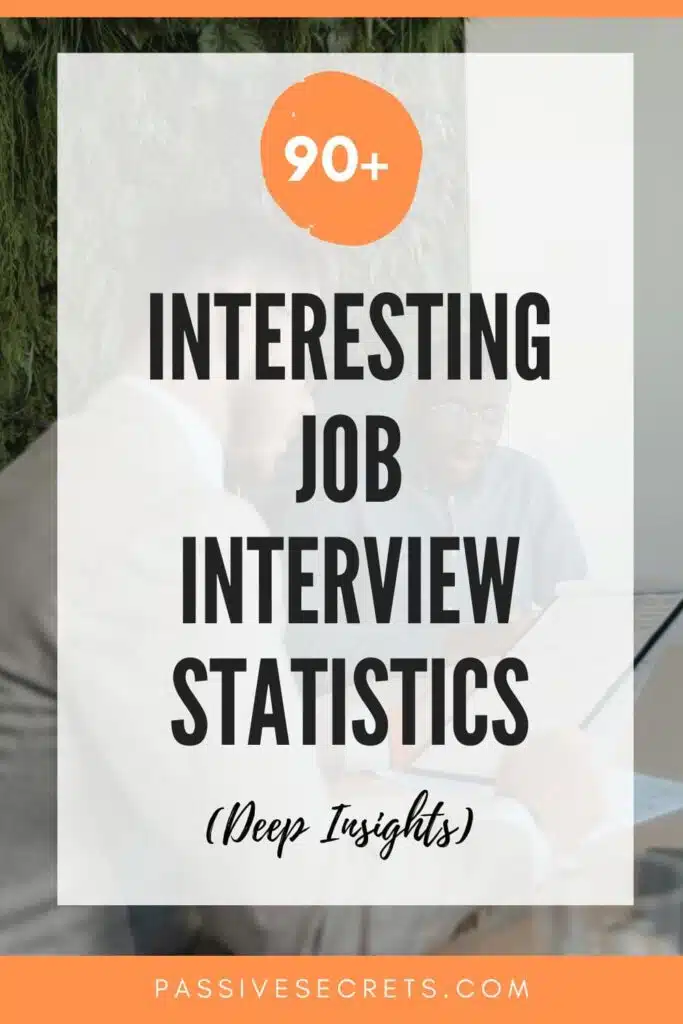
Related Posts
- 80+ Employee Benefit Statistics: Insights and Trends
- The Most Important Wealth Management Statistics You Can’t Afford to Ignore
- Enterprise Data Management: Essential Statistics and Emerging Trends
- 93 Talent Management Statistics to Help You
- Top Reputation Management Statistics and Trends to Improve Your Brand
- 36 Helpful Social Worker Burnout Statistics To Know
- 100 Business Process Outsourcing Statistics & Facts
- Top HR Outsourcing Statistics and Trends Every Business Must Know
- The Top Outsourcing Statistics You Shouldn’t Ignore
- 47+ Shocking 4-day Work Week Statistics To Know
- 105+ Supply Chain Statistics & Facts You Can’t Ignore
- 50+ Interesting Employer Branding Statistics And Trends
- Job Seekers Statistics: Unemployment Rates, Preferences, Challenges
- 60+ Helpful Change Management Statistics & Facts
- 65+ Employee Performance Management Statistics & Trends
- Workforce Management Statistics: Trends, Insights, & Opportunities
- 73 Revealing Workplace Distraction Statistics
- Workplace Romance Statistics: How Common Is Workplace Romance?
- 40+ Top Workplace Conflict Statistics You Should Know
- The State of Workplace Communication: Key Statistics and Trends
- 55 Workplace Collaboration & Teamwork Statistics

